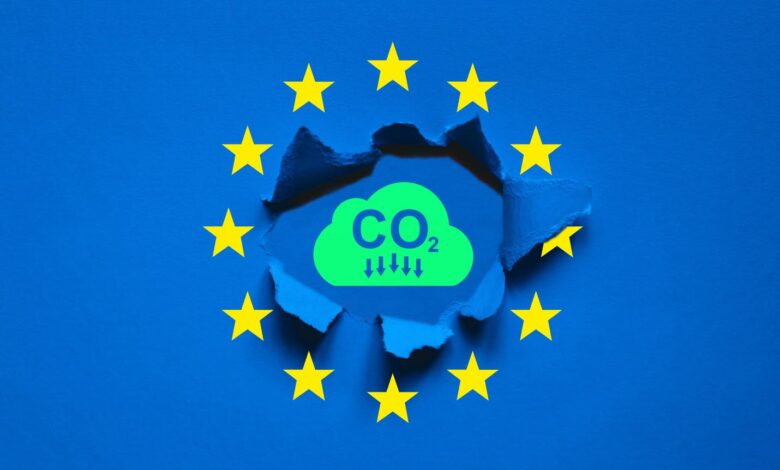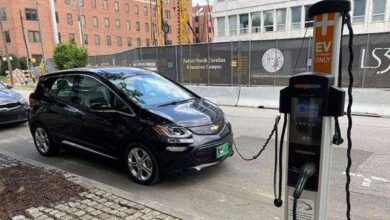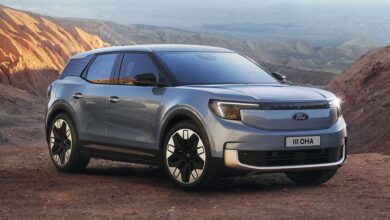Europe’s Wobbling EV Mandate Will Force Hard Choices

Decline in carbon dioxide emissions in Europe.
Europe wants to force its citizens to buy only electric vehicles. The trouble is, EVs are too expensive to generate the kind of mass market sales required as sales of new internal combustion engines between now and 2035 are gradually outlawed.
The question is, where will all these sales come from?
The European Union and the British government find themselves between a rock and a hard place. Local auto manufacturers haven’t the capacity to reach these targets, but the Chinese do. If utopian climate-saving carbon-dioxide cutting targets for 2035 are to be met with the help of cheaper Chinese EVs, this could deal an existential blow to European automakers. To save the European industry by diluting CO2 requirements would mean a loss of political face. An added complication is June’s elections for the European parliament. Some centre-right politicians are running on “save our ICE cars” platforms.
EU election. European Union parliament seats and a voting box on EU flag background, banner. 3d … [+]
There’s another troubling complication. The EU is looking at charges China has been illegally subsidizing EV sales to Europe, and a decision soon on raising import tariffs is expected. But curbing Chinese EV imports could prod China into tit-for-tat action against Germany’s big interests there.
Reuters put the problem this way when describing a similar dilemma in the U.S.
“The Biden administration’s plan to slap heavy new tariffs on Chinese electric vehicles and batteries would provide temporary protection for U.S. auto jobs (but) potentially at the expense of White House efforts to fight climate change by accelerating U.S. EV adoption”.
Current sales of EVs in Europe have stalled at just over 2 million a year, as early adopters and corporate purchasing peaked out. Schmidt Automotive Research said during the opening third of 2024 Western Europe EV market share stalled at 14.4% compared with the same period last year, according to its provisional data. Other leading market forecasters still expect sales to explode and reach close to 9 million in Europe by 2030, a rate of growth that isn’t fast enough to reach the EU and Britain’s target of close to an 80% market share.
In Britain, automakers’ EV sales must account for 22% of overall sales this year, rising to 25% in 2025, 33% in 2026, 38% in 2027, 52% in 2028, 66% in 2029, 80% in 2030 and 100% in 2035. In the EU a roughly similar program to outlaw ICE vehicles is defined by fleet carbon dioxide emissions.
Stellantis CEO Carlos Tavares recently criticized Britain’s EV quotas. EVs currently hold about 15-1/2% of the market there compared with the government mandate of 22%. Companies face a £15,000 ($19,000) fine for every ICE sale above the quota. Tavares said last month Stellantis’s local brands like Citroen, Vauxhall and Peugeot would not sell ICE cars and lose money. This reaction is likely to be repeated across Europe.
BMW CEO Oliver Zipse has called for changes in the 2035 ban on the sale of new ICE vehicles and wants to use taxes to incentivize cuts in CO2 emissions.
UBS cut its forecast for European EV sales to 8.3 million in 2030 compared with its previous estimate of 9.6 million. Investment researcher Jefferies has forecast sales of EVs in Europe will rise to 8.9 million in 2030 for a market share of 65% versus 16% now. Schmidt Automotive Research says EV sales in Western Europe will reach 8.4 million or 60% of the overall market by 2030, compared with just under 2 million in 2023 (16.9%).
The EU adopted this zero-new-ICE-cars-by-2035 decision a year ago, and it must have been aware that Chinese automakers had a huge lead in making world-class EVs. It’s not clear how the politicians expected EV market share to go from 22% to 80% in seven years. Cynics say the plan ignores the theory of unintended consequences and will harm the local auto industry, transfer big benefits to China, and have no impact on the climate. As an election approaches, accusations the plan threatens to make personal transport affordable only for the rich could have negative political consequences.
British-based auto analyst Charles Tennant said the plan will indeed cause turmoil for the industry.
“Already the government target for EV sales of 22% in the U.K. and EU is under threat, amid a global slowdown of EV sales, as customers seemingly turn their backs on electric technology in favor of their beloved internal combustion engine cars – although hybrid vehicle sales are maintaining some momentum – and this puts the 80% U.K./EU target of EV sales by 2030 at serious threat,” Tennant said in an email exchange.
“In the U.K. just 15.2% of new cars registered in March were EVs, down from 16.2% last year, and even this was predominantly fleet sales (30% up) as more people take advantage of the lower tax breaks enjoyed by EV company cars. In growth terms EVs increased by a paltry 4% in the U.K. in March, whereas hybrids surged by 20% in a market that grew by 10.4%. Manufacturers are now beginning to feel this pain as Tesla and the Chinese companies have reported a big fall in their Q1 sales, and legacy manufacturers are reining-in on lofty ambitions to go all-electric between 2030 to 2035,” Tennant said.
Ford Motor, once eager to lead Europe in banning ICE power by 2030, is now hedging its bets. Others who jumped on the anti-ICE bandwagon may face similar embarrassment.
Matt Schmidt of Schmidt Automotive Research says the drive towards zero emissions in 2035 will soon be kickstarted by extended hybridization, and improved plug-in hybrids with EV-only range of more than 60 miles. The industry in the EU is currently pausing EV efforts ahead of the next increase in fleet emissions targets next year. There will also be changes in company car taxation penalizing ICE cars. Big cities will increasingly ban ICE access while insisting taxi services will be electrified.
Signs indicating Ultra Low Emission Zone (ULEZ) on a street in London.
“That should be enough to get them over the finish line,” Schmidt said.
Ben Nelmes, CEO of New AutoMotive, an independent transport research organization with a mission to support the switch to electric vehicles, acknowledges the magnitude of the challenge, but said it is possible if the EU stands behind its plan.
“Any outlook to 2030 would be highly uncertain, and these forecasts look very stretching, but if the EU sticks to its guns then they are eminently achievable. 2030 is a fair way off and carmakers despite problems in recent months can be very nimble,” Nelmes said in an interview.
The elections in June might undermine the EU’s plan. Some centre-right groups want to reverse the ban on the sale of all new ICE vehicles by 2035. Could this derail the plan?
“I don’t think it would do that. There is an increase in parties not in favor of 2035 (CO2 rules) and the EU may have to make compromises, but political negotiations are hard to predict. The elections could be quite consequential for the EV transition in Europe,” Nelmes said.
Nelmes didn’t expect the EU to raise import tariffs on Chinese EVs, now standing at 10%. German investments in China made that unlikely because of the fear of retaliation while raising tariffs would penalize European consumers who wanted to embrace the switch to EVs. Nelmes expected more cooperation between European and Chinese manufacturers.
BYD of China has already announced plans to make cars in Hungary. Multi-brand giant Stellantis has agreed to sell EVs made by Leapmotor of China, in which it holds a 20% stake, and may assemble some under license.
CEO of auto giant Stellantis Carlos Tavares attends a joint media event by Stellantis and Leapmotor … [+]
Tennant agrees that more deals with Chinese companies are likely but the EU has a big decision to take on the tariff issue.
“We can expect to see collaboration. Stellantis has already formed a joint venture with the Chinese car maker Leapmotor to sell compact city cars at a sub €20,000 ($21,700 after tax) price point. This leaves the EU in a quandary where if it follows suit with the U.S. and imposes punitive tariffs on Chinese EV imports to protect legacy manufacturers then it will just be adding another stimy to their aim for EV take up by private mass market customers. It’s all becoming a perfect storm,” Tennant said.



